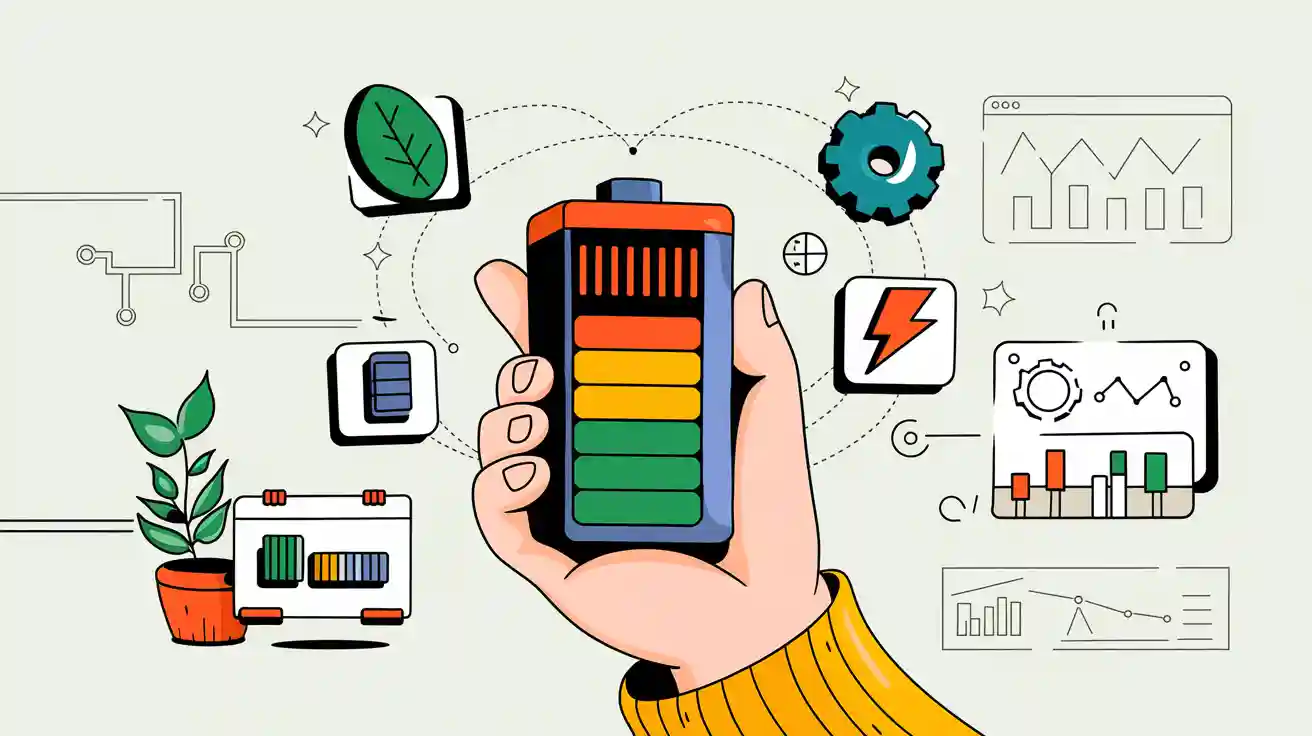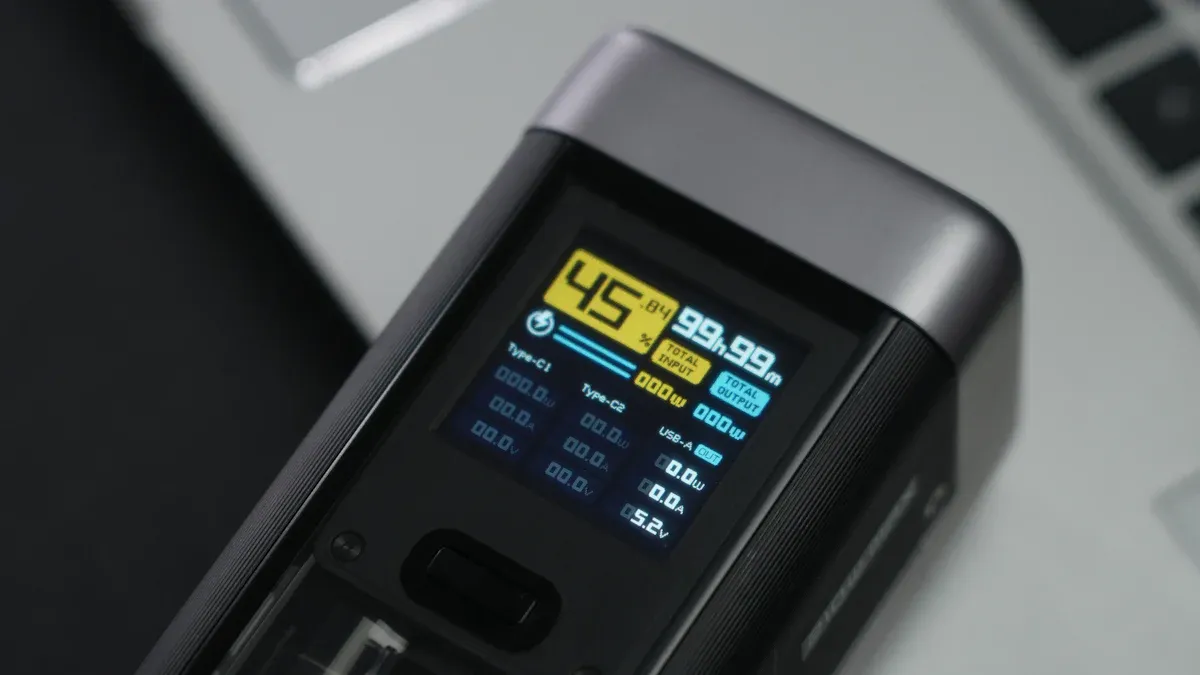
You manage critical systems powered by lithium battery packs. Reliability and optimization matter to your business. Smart battery indicators deliver real-time feedback, helping you avoid risks like thermal runaway and costly downtime.
Predictive analytics and system integration reduce operational costs and build trust.
Key Takeaways
Smart battery indicators provide real-time feedback on battery health, helping you detect issues early and prevent costly failures.
Color-coded status signals simplify battery management, allowing for quick decision-making and enhancing safety.
Implementing predictive analytics can reduce maintenance costs by up to 40% and extend battery life through early detection of issues.
Part 1: Smart Battery Indicators

1.1 Real-Time Feedback
Smart battery indicators give you instant updates on the health and charge levels of your lithium battery packs. You see real-time feedback through integrated sensors that monitor mechanical, thermal, gas, optical, and electrical states. This advanced monitoring helps you detect issues early, preventing failures and reducing downtime.
Real-time feedback uses AI and predictive analytics to analyze historical data and spot at-risk batteries before problems occur. You benefit from qualitative and quantitative diagnostics throughout the battery lifecycle, which improves safety and extends battery life.
Feature | Smart Battery Indicators | Traditional Monitoring Methods |
|---|---|---|
Accuracy of SOC Estimation | 74.5% | 46.1% |
Types of Measurements | Multiple integrated sensors | Current and voltage only |
Additional State Monitoring | Yes | No |
Impact on Safety/Lifespan | Improved | Limited |
Smart battery indicators maximize uptime and lower total cost of ownership by enabling predictive maintenance and adaptive current regulation.
1.2 Color-Coded Status
Color-coded status signals make battery management simple and intuitive. You see green for optimal performance, yellow for caution, and red for critical alerts. This visual system lets you make quick decisions and builds trust in your battery packs.
Consistent indicator systems help you avoid confusion and errors.
You gain confidence in your lithium battery packs, knowing you have reliable, easy-to-understand feedback.
Enhanced safety and efficiency set smart battery indicators apart from conventional solutions.
Smart battery indicators, paired with an integrated BMS, prevent overcharging and overheating. You get real-time updates and advanced control, ensuring stability and long lifespan for your lithium battery packs.
Part 2: Battery Management System (BMS)

2.1 Active Monitoring
You rely on battery management systems to keep your lithium battery packs safe and efficient. These systems act as the brain for batteries, constantly monitoring critical parameters such as voltage, current, temperature, State of Charge (SOC), State of Health (SOH), Depth of Discharge (DOD), and State of Function (SOF). In industrial environments, active monitoring helps you avoid costly failures and downtime. The BMS uses sensors and software to collect data and diagnose issues before they escalate.
IoT battery systems transform how you manage batteries. With IoT, you receive continuous data streams from distributed battery systems, gaining dynamic insights into battery performance and health. AI-powered BMS analyze real-time data to predict battery performance, adapt to unique battery characteristics, and optimize safety. Predictive analytics identify potential faults, allowing you to take preventive actions and schedule maintenance before problems occur.
Tip: Early identification of issues through battery health monitoring improves reliability and extends battery lifespan.
You see measurable benefits from active monitoring:
Continuous assessment of battery function prevents damage and enhances battery performance.
Cell balancing technology optimizes charge levels across individual cells, promoting longevity.
Early identification of potential issues through SOH monitoring improves reliability.
Preventive maintenance and timely replacements reduce the risk of catastrophic failures.
Protection against overcharging, overheating, and excessive discharging ensures safe operation.
IoT battery systems support applications in medical, robotics, security, infrastructure, consumer electronics, and industrial sectors. You benefit from enhanced efficiency and safety, whether you use lithium-ion, LiFePO4, lithium-polymer/LiPo, or Solid-State Battery chemistries.
Feature | Description |
|---|---|
Real-time Data Acquisition | IoT enables continuous data streams from distributed battery systems, providing dynamic insights. |
Predictive Analytics | AI uses data-driven models to predict battery performance and health, enhancing proactive maintenance. |
Enhanced Monitoring | Critical parameters like temperature, voltage, and current are monitored in real-time. |
2.2 Preventing Overcharging
Battery management systems play a crucial role in preventing overcharging, which remains a leading cause of battery failures in commercial settings. Overcharging can result in overheating, smoking, fires, or explosions. You must address this risk to protect your assets and ensure operational continuity.
Statistics show that 54% of businesses have faced incidents like smoking, overheating, or explosions linked to lithium-ion batteries. Fires or explosions affected 19% of businesses, while 36% reported overheating. Only 52% of businesses that experienced incidents actively avoid overcharging, highlighting the importance of robust BMS solutions.
You can prevent overcharging by:
Setting the protection voltage in your BMS lower than the peak voltage during charging.
Improving anti-overcharge capability through material modification.
Adding anti-overcharge additives to the electrolyte.
Using voltage-sensitive film to reduce resistance during overcharge.
Implementing OSD and CID designs in battery construction.
To further reduce risk, follow these steps:
Choose the right charger for your battery chemistry, such as a charger designed for LiFePO4 batteries.
Leverage your BMS over-current protection by ensuring proper calibration.
Monitor voltage and temperature using IoT apps or volt-meters during charging.
Set proper charge parameters, maintaining a maximum float voltage of 3.40–3.45V per cell and limiting charge current to around 0.2C.
Battery Chemistry | Platform Voltage (V) | Energy Density (Wh/kg) | Cycle Life (cycles) | Application Scenario |
|---|---|---|---|---|
LiFePO4 | 3.2 | 90–140 | 2000–7000 | Industrial, Medical, Infrastructure |
NMC | 3.7 | 150–220 | 1000–2000 | Consumer Electronics, Robotics |
LCO | 3.7 | 150–200 | 500–1000 | Consumer Electronics |
LMO | 3.7 | 100–150 | 300–700 | Security, Consumer Electronics |
LTO | 2.4 | 70–80 | 7000–20000 | Industrial, Infrastructure |
You gain confidence in your battery management system when you see real-time alerts for abnormal parameter values. The system allows you to intervene early, preventing failures and maximizing efficiency. IoT battery systems and AI-driven monitoring provide the tools you need to optimize charging, discharging, and overall battery performance.
Note: For advanced BMS solutions and custom consultation, visit BMS internal link.
Part 3: Power Management Strategies
3.1 Smart Charging
You optimize battery performance in your industrial, medical, robotics, security, infrastructure, and consumer electronics systems by using smart charging algorithms. These algorithms analyze real-time data from IoT battery systems, adjusting charging profiles based on battery health and environmental conditions. You see improved battery optimization and reduced energy costs. Smart charging enables automatic charging during off-peak hours, which lowers your energy bills and supports a resilient grid.
Smart charging algorithms provide dynamic control mechanisms for IoT battery systems, replacing fixed-parameter charging approaches with intelligent, real-time optimization. These systems analyze battery condition and environmental factors to determine optimal charging profiles for individual devices.
You manage charging cycles and adopt partial charges to extend battery lifespan. Charging to 80% and avoiding deep discharge help you maintain battery health and reliability.
Best Practice | Description |
|---|---|
Manage Charging Cycles | Track and control each charge/discharge event to avoid unnecessary full cycles. |
Adopt Partial Cycles | Use partial charges and discharges to reduce wear and extend battery lifespan. |
Charge to 80% | Limit charging to about 80% to lower cell stress and slow down capacity loss. |
Avoid Deep Discharge | Keep battery levels above 25% to prevent damage and maintain long-term performance. |
3.2 Predictive Analytics
You leverage predictive analytics in IoT battery systems to forecast battery health and maintenance needs. Real-time monitoring detects subtle signs of deterioration, allowing you to schedule focused repairs and extend battery life. AI and machine learning models in IoT battery systems are ten times more accurate than traditional methods for assessing battery health. You reduce maintenance costs by up to 40% and prevent unexpected failures.
Benefit | Description |
|---|---|
Early Detection of Issues | Predictive analytics identifies subtle signs of battery deterioration before they become noticeable. |
Focused Repairs | Maintenance is based on actual data, leading to necessary repairs and extended battery life. |
Improved Battery Life | Helps in diagnosing vehicle issues that may affect battery performance, preventing capacity loss. |
Cost Savings | Reduces emergency repair costs and minimizes downtime, impacting the financial bottom line positively. |
Predictive analytics in IoT battery systems enable early detection of issues such as unusual voltage drops.
You intervene promptly, preventing costly battery replacements and maximizing battery optimization.
3.3 Optimal Power Distribution
You achieve optimal power distribution in multi-battery systems by managing depth of discharge (DOD) and state of charge (SOC). Maintaining a moderate DOD between 20% and 80% minimizes stress on electrodes and extends battery lifespan. IoT battery systems with real-time monitoring and smart charging algorithms balance power across cells, improving system reliability and performance.
The deployment of IoT battery-powered devices creates unprecedented demands for efficient power management systems. Technologies such as LoRa enable effective real-time monitoring capabilities for lithium-ion battery management systems, extending operational battery life and optimizing overall system performance.
Thermal management systems in IoT battery systems use cooling mechanisms to dissipate excess heat during charging. You prevent overheating and maintain consistent battery temperature, which improves performance, longevity, and safety.
Key Metric | Value |
|---|---|
System Reliability Improvement | |
Peak Demand Reduction | About 17% |
Planning Horizon | One year |
Overheating causes rapid degradation and reduces battery lifespan.
Effective thermal management is crucial for safe operation in demanding sectors such as medical, industrial, and robotics.
Part 4: Battery Optimization and User Experience
4.1 Performance Gains
You see measurable improvements when you implement advanced battery optimization strategies in your operations. Smart charging algorithms, real-time monitoring, and predictive maintenance all contribute to higher efficiency and reliability in iot battery systems. The table below compares the outcomes of these strategies, highlighting their impact on performance and user satisfaction across sectors like medical, robotics, security, infrastructure, consumer electronics, and industrial:
Strategy | Performance Gain |
|---|---|
Smart charging algorithms | Increases energy efficiency by up to 21% |
Real-time monitoring systems | Reduces maintenance visits by 75% |
Predictive maintenance | Delivers 30-40% cost savings compared to reactive approaches |
AI-powered state estimation | Achieves error rates below 2% for battery health predictions |
Low-power protocols (LoRa) | Enables battery life exceeding 10 years |
Modular, scalable designs | Addresses the 75% IoT project failure rate |
You benefit from reduced downtime, longer battery life, and lower operational costs. Charging schedules in iot battery systems minimize waiting times, while intelligent battery management extends battery lifespan and reduces maintenance demands. Integration with renewable energy sources also supports your sustainability goals.
Aspect | Effect on Reliability and User Satisfaction |
|---|---|
Charging Schedules | Reduces waiting times at charging stations, enhancing user experience |
Intelligent Battery Management | Extends battery life, reducing maintenance demands |
Integration with Renewable Energy | Lowers carbon footprint, contributing to sustainability goals |
4.2 UI/UX in Battery Systems
You interact with iot battery systems through interfaces designed for clarity and efficiency. User-centered design ensures you can easily monitor battery status and performance. Key UI/UX features include:
User-centered design that addresses your needs and pain points.
Usability for straightforward operation and quick access to critical battery data.
Aesthetics that build trust through professional, appealing visuals.
Accessibility for users with disabilities.
Consistency in visuals and controls.
Efficiency that guarantees fast, responsive system performance.
Data visualization plays a crucial role in real-time monitoring and energy optimization. You receive real-time updates every second, allowing you to diagnose issues quickly. You can switch between parameters, compare multiple measurements, and analyze data from different locations in a single interface. Live visualizations and drill-down capabilities help you identify trends and anomalies, supporting timely decisions and optimal battery management.
Tip: Automated alerts and notifications in iot battery systems keep you informed, so you can act before minor issues become major problems.
You gain measurable business value by integrating smart battery indicators and advanced power management into your battery energy storage system. Real-time monitoring, predictive maintenance, and state of health tracking drive efficiency and reliability.
Measurable Impact | Description |
|---|---|
Improved Efficiency | Enhanced energy management across applications. |
Predictive Maintenance | Early fault prediction reduces downtime and costs. |
Extended Battery Lifespan | Usage tracking suggests optimal strategies. |
Real-time diagnostics and dynamic balancing support optimal performance.
Over-the-air updates and enhanced integration streamline your operations.
FAQ
What advantages do smart battery indicators offer for predictive maintenance in renewable energy systems?
Smart battery indicators help you track battery health in renewable energy systems. You use predictive maintenance to reduce downtime and improve system reliability.
How does Large Power support predictive maintenance approach for different lithium battery chemistries?
Large Power provides custom battery consultation for predictive maintenance approach. You optimize LiFePO4, NMC, LCO, LMO, and LTO batteries for medical, robotics, security, infrastructure, consumer electronics, and industrial sectors.
Battery Chemistry | Platform Voltage (V) | Energy Density (Wh/kg) | Cycle Life (cycles) | Application Scenario |
|---|---|---|---|---|
LiFePO4 | 3.2 | 100–180 | 2000–7000 | Industrial, Medical, Infrastructure |
NMC | 3.7 | 160–270 | 1000–2000 | Consumer Electronics, Robotics |
LCO | 3.7 | 180–230 | 500–1000 | Consumer Electronics |
LMO | 3.7 | 120–170 | 300–700 | Security, Consumer Electronics |
LTO | 2.4 | 60–90 | 10000–20000 | Industrial, Infrastructure |
How can predictive maintenance improve energy utilization efficiency in renewable energy systems?
You use predictive maintenance to monitor battery performance. This approach increases energy utilization efficiency and extends battery life in renewable energy systems.




